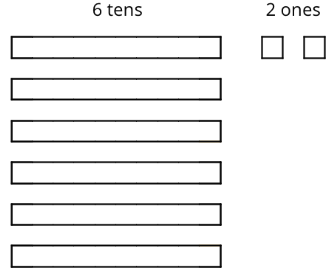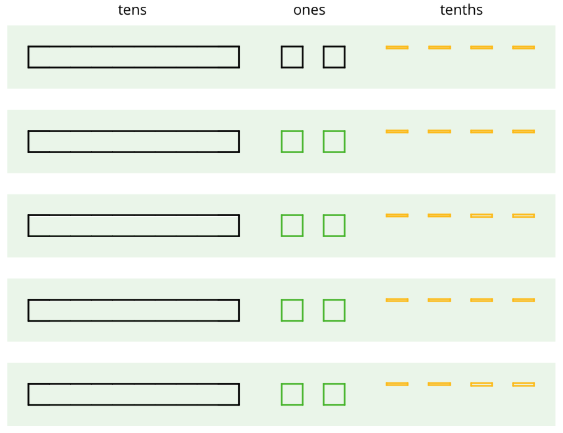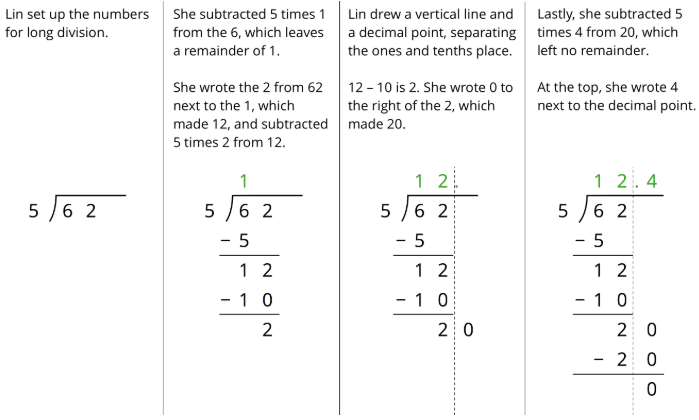29.3: Dividing Numbers that Result in Decimals
- Page ID
- 40308
Lesson
Let's find quotients that are not whole numbers.
Exercise \(\PageIndex{1}\): Number Talk: Evaluationg Quotients
Find the quotients mentally.
\(400\div 8\)
\(80\div 8\)
\(16\div 8\)
\(496\div 8\)
Exercise \(\PageIndex{2}\): Keep Dividing
Mai used base-ten diagrams to calculate \(62\div 5\). She started by representing \(62\).

She then made 5 groups, each with 1 ten. There was 1 ten left. She unbundled it into 10 ones and distributed the ones across the 5 groups.
Here is Mai’s diagram for \(62\div 5\).

- Discuss these questions with a partner and write down your answers:
- Mai should have a total of 12 ones, but her diagram shows only 10. Why?
- She did not originally have tenths, but in her diagram each group has 4 tenths. Why?
- What value has Mai found for \(62\div 5\)? Explain your reasoning.
- Find the quotient of \(511\div 5\) by drawing base-ten diagrams or by using the partial quotients method. Show your reasoning. If you get stuck, work with your partner to find a solution.
- Four students share a $271 prize from a science competition. How much does each student get if the prize is shared equally? Show your reasoning.
Exercise \(\PageIndex{3}\): Using Long Division to Calculate Quotients
Here is how Lin calculated \(62\div 5\).

- Discuss with your partner:
- Lin put a 0 after the remainder of 2. Why? Why does this 0 not change the value of the quotient?
- Lin subtracted 5 groups of 4 from 20. What value does the 4 in the quotient represent?
- What value did Lin find for \(62\div 5\)?
- Use long division to find the value of each expression. Then pause so your teacher can review your work.
- \(126\div 8\)
- \(90\div 12\)
- Use long division to show that:
- \(5\div 4\), or \(\frac{5}{4}\), is \(1.25\).
- \(4\div 5\), or \(\frac{4}{5}\), is \(0.8\).
- \(1\div 8\), or \(\frac{1}{8}\), is \(0.125\).
- \(1\div 25\), or \(\frac{1}{25}\), is \(0.04\).
- Noah said we cannot use long division to calculate \(10\div 3\) because there will always be a remainder.
- What do you think Noah meant by “there will always be a remainder”?
- Do you agree with him? Explain your reasoning.
Summary
Dividing a whole number by another whole number does not always produce a whole-number quotient. Let’s look at \(86\div 4\), which we can think of as dividing 86 into 4 equal groups.

We can see in the base-ten diagram that there are 4 groups of 21 in 86 with 2 ones left over. To find the quotient, we need to distribute the 2 ones into the 4 groups. To do this, we can unbundle or decompose the 2 ones into 20 tenths, which enables us to put 5 tenths in each group.
Once the 20 tenths are distributed, each group will have 2 tens, 1 one, and 5 tenths, so \(86\div 4=21.5\).

We can also calculate \(86\div 4\) using long division.
The calculation shows that, after removing 4 groups of 21, there are 2 ones remaining. We can continue dividing by writing a 0 to the right of the 2 and thinking of that remainder as 20 tenths, which can then be divided into 4 groups.
To show that the quotient we are working with now is in the tenth place, we put a decimal point to the right of the 1 (which is in the ones place) at the top. It may also be helpful to draw a vertical line to separate the ones and the tenths.
There are 4 groups of 5 tenths in 20 tenths, so we write 5 in the tenths place at the top. The calculation likewise shows \(86\div 4=21.5\).
Glossary Entries
Definition: Long Division
Long division is a way to show the steps for dividing numbers in decimal form. It finds the quotient one digit at a time, from left to right.
For example, here is the long division for \(57\div 4\).

Practice
Exercise \(\PageIndex{4}\)
Use long division to show that the fraction and decimal in each pair are equal.
\(\frac{3}{4}\) and \(0.75\qquad\frac{3}{50}\) and \(0.06\qquad\frac{7}{25}\) and \(0.28\)
Exercise \(\PageIndex{5}\)
Mai walked \(\frac{1}{8}\) of a 30-mile walking trail. How many miles did Mai walk? Explain or show your reasoning.
Exercise \(\PageIndex{6}\)
Use long division to find each quotient. Write your answer as a decimal.
- \(99\div 12\)
- \(216\div 5\)
- \(1,988\div 8\)
Exercise \(\PageIndex{7}\)
Tyler reasoned: “\(\frac{9}{25}\) is equivalent to \(\frac{18}{50}\) and to \(\frac{36}{100}\), so the decimal of \(\frac{9}{25}\) is 0.36.”
- Use long division to show that Tyler is correct.
- Is the decimal of \(\frac{18}{50}\) also \(0.36\)? Use long division to support your answer.
Exercise \(\PageIndex{8}\)
Complete the calculations so that each shows the correct difference.

(From Unit 5.2.3)
Exercise \(\PageIndex{9}\)
Use the equation \(124\cdot 15=1,860\) and what you know about fractions, decimals, and place value to explain how to place the decimal point when you compute \((1.24)\cdot (0.15)\)
(From Unit 5.3.2)

